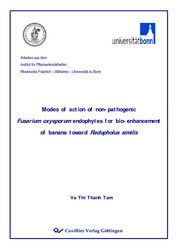| Departments | |
|---|---|
| Book Series (96) |
1377
|
| Nachhaltigkeit |
3
|
| Gesundheitswesen |
1
|
| Humanities |
2361
|
| Natural Sciences |
5403
|
| Mathematics | 229 |
| Informatics | 318 |
| Physics | 979 |
| Chemistry | 1362 |
| Geosciences | 131 |
| Human medicine | 243 |
| Stomatology | 10 |
| Veterinary medicine | 108 |
| Pharmacy | 147 |
| Biology | 835 |
| Biochemistry, molecular biology, gene technology | 121 |
| Biophysics | 25 |
| Domestic and nutritional science | 45 |
| Agricultural science | 1004 |
| Forest science | 201 |
| Horticultural science | 20 |
| Environmental research, ecology and landscape conservation | 148 |
| Engineering |
1788
|
| Common |
97
|
|
Leitlinien Unfallchirurgie
5. Auflage bestellen |
|
Advanced Search
Modes of action of non-pathogenic Fusarium oxysporum endophytes for bio-ehancement of banana toward Radopholus similis (English shop)
Vu Thi Thanh Tam (Author)Preview
Table of Contents, Datei (64 KB)
Extract, Datei (270 KB)
Recently, mutualistic endophytic F. oxysporum isolates were documented as candidates for biological control against plant parasitic nematodes. However, understanding their mechanisms of action toward R. similis was poorly known. The following can be summarized from the present findings:
1. Pathogenicity of endophytic F. oxysporum isolates toward R. similis
Non-pathogenic endophytic F. oxysporum isolates directly affected R. similis survival in the absence of banana plants. In both synthetic media and in the soil, F. oxysporum isolates decreased mobility of R. similis when compare to the untreated controls. F. oxysporum was not shown to be a parasite of the nematode. Toxins in culture filtrates of F. oxysporum isolates Fo162 and V5W2 reduced mobility of R. similis in vitro; however the toxic effects were not lethal.
2. Colonization, plant growth promotion and vegetative compatibility of endophytic F.oxysporum
The F. oxysporum isolates Fo162 and V5W2 not only colonized excellently on banana roots a short time after fungal application but also persisted in the root tissues for over 14 weeks. The
F. oxysporum isolates also promoted banana growth in long term experiments in the absence of R. similis. The F. oxysporum isolates A1, Fo162 and V5W2 were shown to be unrelated genetically tothe important pathogenic Fusarium wilt diseases of bananas and tomatoes by VCG testing. Therefore, these mutualistic endophytic F. oxysporum isolates are not only beneficial and
non-pathogenic on bananas but also are not pathogenic to other crops. These results indicate that endophytic F. oxysporum isolates A1, Fo162 and V5W2 are strong candidates for biocontrol in the field.
3. Modes of action of non-pathogenic endophytic F. oxysporum isolates toward burrowing nematode R. similis on banana
The F. oxysporum isolates reduced nematode penetration in banana plants when compared to untreated controls. The F. oxysporum not only reduced R. similis penetration, but also reduced nematode population density in banana root after 12 weeks. Timing, inoculum concentration and the ability of the F. oxysporum to colonize banana roots strongly influence the level of biological control activity against R. similis. F. oxysporum metabolites affected the mobility of R. similis in vitro but did not affect R. similis penetration in soil. The endophytic F. oxysporum decreased attraction and the host finding ability of R. similis. F. oxysporum may induce toxic substances like pathogenesis related proteins, change root exudates that obstruct or repel attraction of R. similis to banana or reduce nematode recognition. All the isolates of F. oxysporum used induced systemic resistance against R. similis infestation in banana. Induced systemic resistance was clearly demonstrated to be the essential first step in the mode of action of non-pathogenic endophytic F. oxysporum and indicates that protection mainly results from initiation of induced systemic resistance coupled with changes in host finding ability. Changes in banana root proteins following treatment with F. oxysporum isolates Fo162 and V5W2 detected by 1D-SDS-Polyacrylamide gel electrophoresis were discovered. Small differences between fungal treatments and the controls were observed, however they were not clear and therefore should be analysed further with 2D- Polyacrylamide gel electrophoresis.
| ISBN-13 (Printausgabe) | 3865374751 |
| ISBN-13 (Hard Copy) | 9783865374752 |
| ISBN-13 (eBook) | 9783736914759 |
| Language | German |
| Page Number | 120 |
| Edition | 1 Aufl. |
| Publication Place | Göttingen |
| Place of Dissertation | Bonn |
| Publication Date | 2005-02-16 |
| General Categorization | Dissertation |
| Departments |
Agricultural science
|








